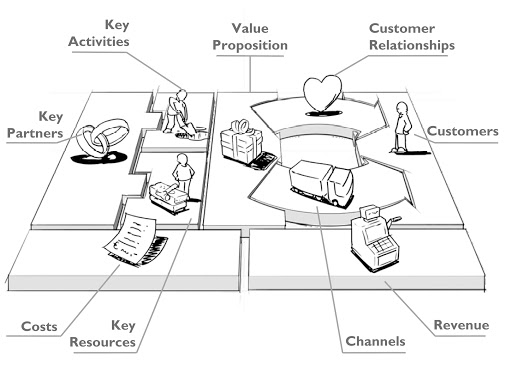The Canvas Business Model: A three-level vision of your restuarant
Business models are essential to organize your business: they describe what an organization really does, who it does it for and how the various elements are related to each other.
The Business Model Canvas is often used to better represent and understand business models. This allows you to acquire a vision at three levels:
• firm-level,
• team-level,
• Individual- level
What is the Business Model Canvas and how does it work?

The Canvas is a single sheet of paper, with nine different rectangular blocks (called “building blocks”), common to all businesses, each of which describes people, places, objects, resources and actions necessary for the business to function. They are:
1. Key partners: people or realities that provide fundamental help or resources to make their business model work;
2. Key activities: actions necessary to create, sell and transfer value proposals to customers;
3. Key resources: human, material, financial or intangible resources necessary to generate and offer value proposals to customers;
4. Value propositions: benefits (solution to certain problems or satisfaction of specific needs) transmitted thanks to the organization’s services or products;
5. Customer relations: marketing process with which the company communicates, sells and distributes value to customers (from product/service promotion to follow-up);
1. Customer segments: distinct groups to which the company addresses, which benefit from value propositions;
2. Channels: channels through which companies communicate, sell and transfer value proposals;
3. Cost structure: expenses (fixed or variable) necessary for the acquisition of key resources, the performance of Key Activities and collaborations with Key Partners;
4. Revenue flows: turnover that the company produces thanks to the funds received from customers who pay to obtain value proposals. A business model is sustainable only if the Revenue Flows exceed, or equate, the costs.
This reveals job interdependencies and allows people who think about their work to feel more related to each other in terms of tasks and not in group vision; it also helps to understand how the organization works and how each person produces work.
Let’s try to apply this model to a restaurant.
The restaurant can be divided in two parts:
• the room, which corresponds to the right part of the Business Model canvas, i.e. the part in direct contact with customers;
• The kitchen, with the back room, to the left of the Canvas, which represents the internal aspects of the organization, which customers do not see.
The tasks of each restaurant employee are clear, but it is important that everyone understands that their actions have direct consequences for customers. These effects can be represented through a Teamwork Table: this shows each person what the roles, tasks and consequences, positive and negative, of his performances are. For each team member it reports role, tasks, result of a successful task and results in case of failure.

The duties of all employees are physically related, so they must necessarily work together to be efficient in their role.
Thanks to the use of the Canvas and the Teamwork table, it is possible to place the work of each team member in the overall logic of the restaurant and realize how everyone’s daily activities generate direct benefits for the customers.
Now you just have to take a paper, pen and post-it and start writing the Business Model Canvas of your restaurant.

